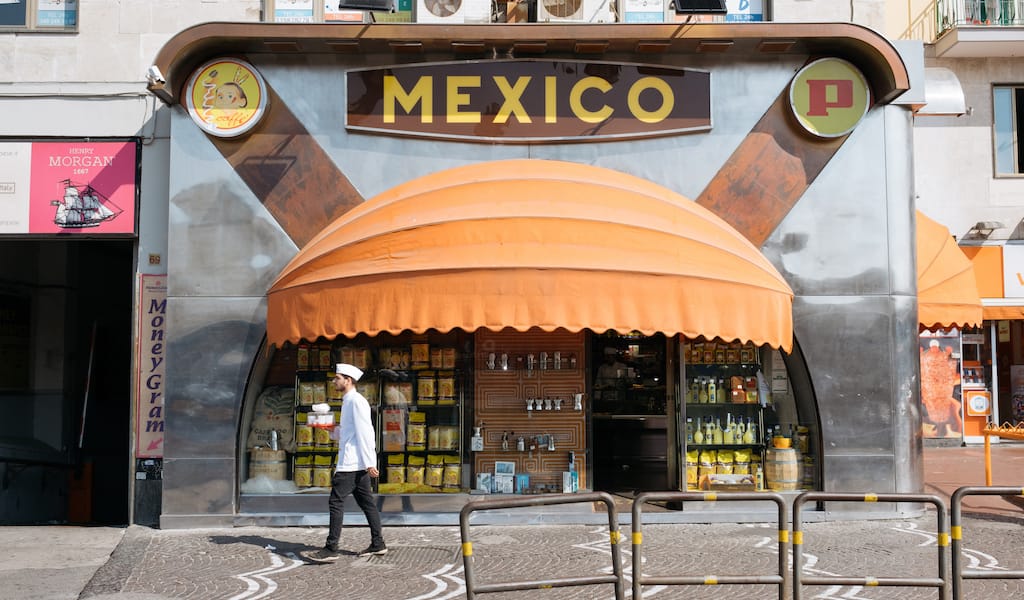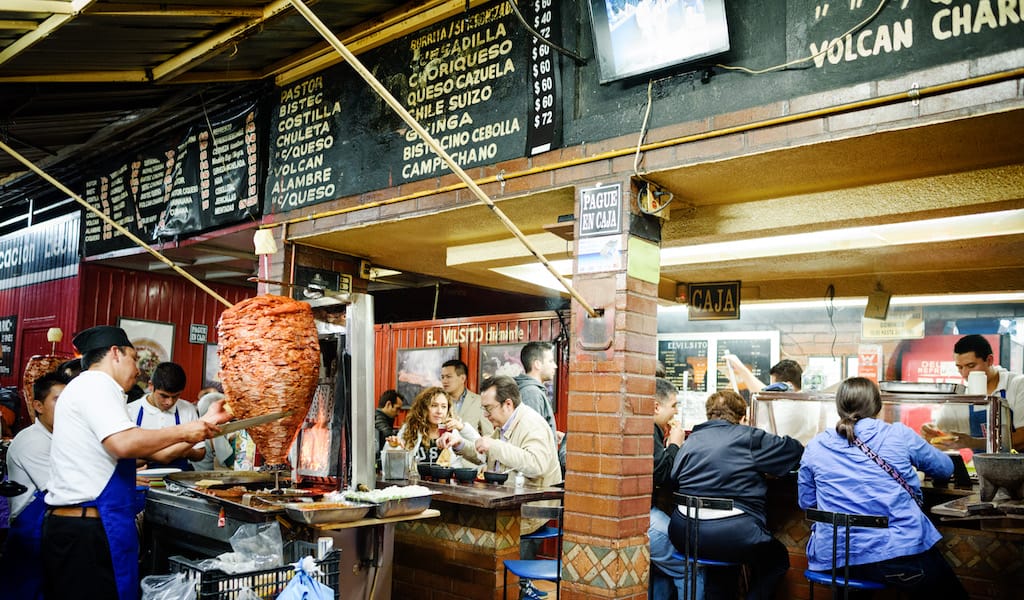Some people believe that a cup of coffee is the same everywhere. We like to think that they haven’t been to one of the Mexico cafés in Naples, where even a coffee novice can understand he has come face-to-face with a very special brew, one that took years to perfect.
When you enter a Caffè Mexico – there are three in Naples – an extraordinary smell envelops you. It is the smell of history, one that often seeps into furniture and timeworn objects. The main source of this smell is coffee (the Passalacqua brand, named after the café’s founder), both from the grinder, operated by a dedicated member of staff, and also the retail counter, where coffee beans are constantly being scooped and weighed and packaged, releasing their aroma throughout the room.

All three bars are straight out of the 60s with their stainless steel and orange plastic accents, a design that was certainly futuristic when Samuele Passalacqua opened the first Mexico bar, this one in Piazza Dante, in 1960. The other two outposts on Piazza Garibaldi and Via Scarlatti were established not long after.
Just as the décor is a blast from the past, so too is the unique system for buying your coffee: you first pay the cashier, who then hands you a receipt and a colored coupon that you bring to the counter. The coupon, whose color is determined by your choice of coffee, allows customers to be served in order of arrival – no preferential treatment here.
Coffee was the passion and profession of Samuele Passalacqua. After the Second World War, Samuele, who up to that point had worked at food businesses in varying capacities, had the opportunity to buy a coffee roasting machine; he soon started selling his own roasted beans. Since Naples is a large commercial port, he was lucky enough to have many different coffee varieties at his fingertips, which allowed him to make increasingly delicious blends.
The success of his coffee business inspired Samuele to open three tasting points in Naples in the 60s. The response was so swift and so positive that the great Italian writer Mario Soldati wrote in La Stampa, a Turin newspaper, that Passalacqua was “the best coffee in Italy.” And after almost 60 years, we can still say the same thing: this is the best coffee in Italy (and, dare we say, the world).
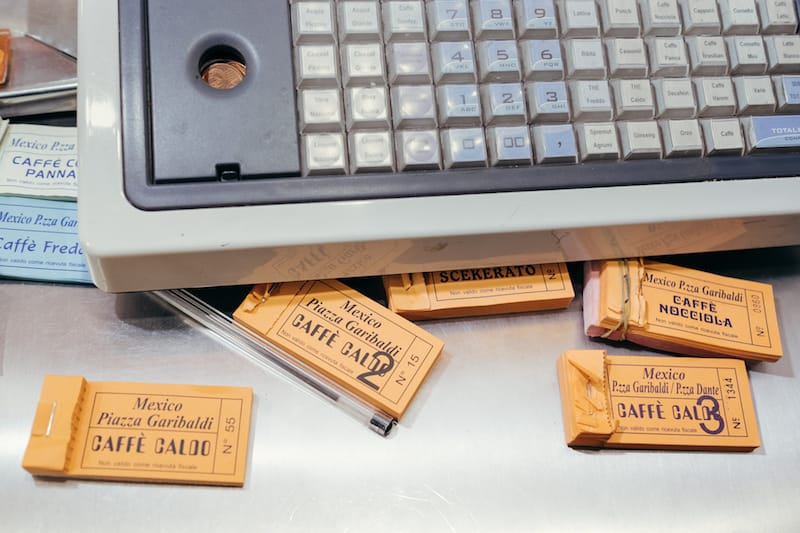
Samuele’s sons, Biagio, Armando and Emilio, eventually assumed their father’s mantle, making Passalacqua and the various Mexico cafés a roaring success. Today their children and grandchildren, the fourth generation of coffee producers, are running the show.
The popularity of Mexico doesn’t seem to be waning: people crowd in front of the counter, drinking their coffee while standing. “I think it’s really the best in town,” says Monica, a clerk who comes here every morning for her coffee.
“This is the real traditional Neapolitan coffee,” the friendly baristas chime in. That’s because the “five Ms” are respected at Mexico:
Miscela (Blend): Without a great blend, it is impossible to make a good coffee.
Macinino (Grinder): A fundamental aspect of good coffee is how finely ground it is, a factor that can change depending on the weather.
Macchina (Machine): An efficient espresso machine is required to get the coffee a perfect temperature.
Manico (Handle): The barista’s experience, it goes without saying, is crucial to a good cup of coffee.
Manutenzione (Maintenance): The machines must always be clean and in perfect working order.
At Caffè Mexico in Piazza Garibaldi, a sign reading “Coffee is served sweetened” welcomes customers. So if you want it bitter, without any sugar, you have to tell the baristas when you deposit your coupon and tip on the counter.
The barista’s experience, it goes without saying, is crucial to a good cup of coffee.
About that tip: in Italy there is no fixed rule about tipping in bars or restaurants, unlike in the U.S., where tipping a certain percentage is expected. (One reason why Italian waiters love American customers is because they leave generous tips.)
There is only one situation in which Neapolitans consider it mandatory to tip: at the bar counter. Here, and only here, it is necessary to deposit a small coin next to the coupon or receipt; it is an unwritten rule but one that has been ingrained in us since childhood.
So while Neapolitans manage to avoid tipping waiters in restaurants, they wouldn’t dare forget to tip the authoritative figure who makes them their coffee. In fact, if a Neapolitan doesn’t have so much as a dime, he is so embarrassed that he apologizes to the bartender.
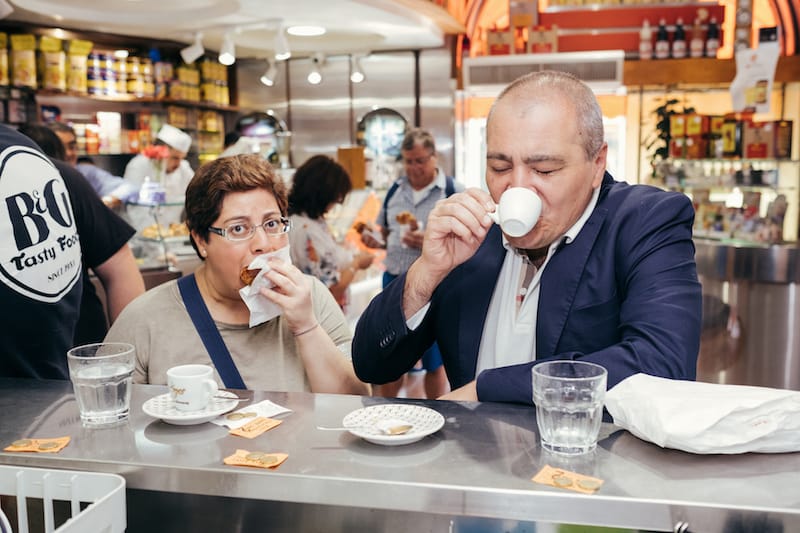
Once they have their coffee in hand, take note of how Neapolitans avoid burning their lips on the hot cup. Using the small spoon that comes with their order, they’ll pour a bit of coffee on the edge of the cup to cool it down. We recommend that you do the same.
The standard coffee served by Mexico is the Moana blend, which is a blend of 10-12 different types of Arabica coffee. On request it is possible to get a cup of the higher-quality Harem coffee, but in our opinion the Moana does the trick. And if you want to buy coffee for home, you’ll be spoiled for choice: the Alambra, Mehari, Cremador, Creamy Cremador, Mekico and Moana blends are all outstanding.
In warmer weather, it is mandatory to taste Mexico’s coffee frappé, a classic of the Neapolitan coffeehouse, made by shaking coffee, sugar and water, that was born well before the thousands of creamy coffee concoctions invaded the city. “It’s the real frappé, in a huge glass, it’s almost a carnal pleasure,” says Mario, a local shopkeeper, whom we run into at the Mexico on Via Scarlatti.
But come summer, a true Neapolitan will order a nice coffee frappé – only to be followed by a hot coffee. Some habits are just too hard to break.
This article was originally published on February 12, 2019.
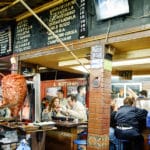 January 14, 2020 Going Deep
January 14, 2020 Going Deep
As the calendar year turns over, we’ve grown accustomed to the barrage of lists telling […] Posted in Tokyo, Special category April 11, 2019 Wenxiang Manchurian Dumpling House
April 11, 2019 Wenxiang Manchurian Dumpling House
When it comes to Chinese dumplings, fish is likely not the first filling that springs to […] Posted in Shanghai April 15, 2020 CB Cooks
April 15, 2020 CB Cooks
Another Instagram Live series we’re launching is CB Cooks, which will bring our walk […] Posted in Athens
Published on March 03, 2021
Related stories
January 14, 2020
Special category | By Culinary Backstreets
Special categoryAs the calendar year turns over, we’ve grown accustomed to the barrage of lists telling us where to travel during the next 12 months. Often these places are a country or even a whole region – you could spend an entire year exploring just one of the locations listed and still barely make a dent.…
April 11, 2019
ShanghaiWhen it comes to Chinese dumplings, fish is likely not the first filling that springs to mind. But that’s probably because you haven’t had the chance to try Liaoning province’s specialty: boiled mackerel dumplings. Dishes from Liaoning, which is located northeast of Beijing, fall under the regional umbrella of Dongbei (northeastern) cuisine. The staple grain…
April 15, 2020
Athens | By Culinary Backstreets
AthensAnother Instagram Live series we’re launching is CB Cooks, which will bring our walk leaders into your home for a live cooking demonstration. First up is Carolina Doriti, our Athens bureau chief, who will be cooking galatopita, a Greek milk pie, on Sunday, April 19, at 11 a.m. EDT (GMT-4). If you want to cook…







































